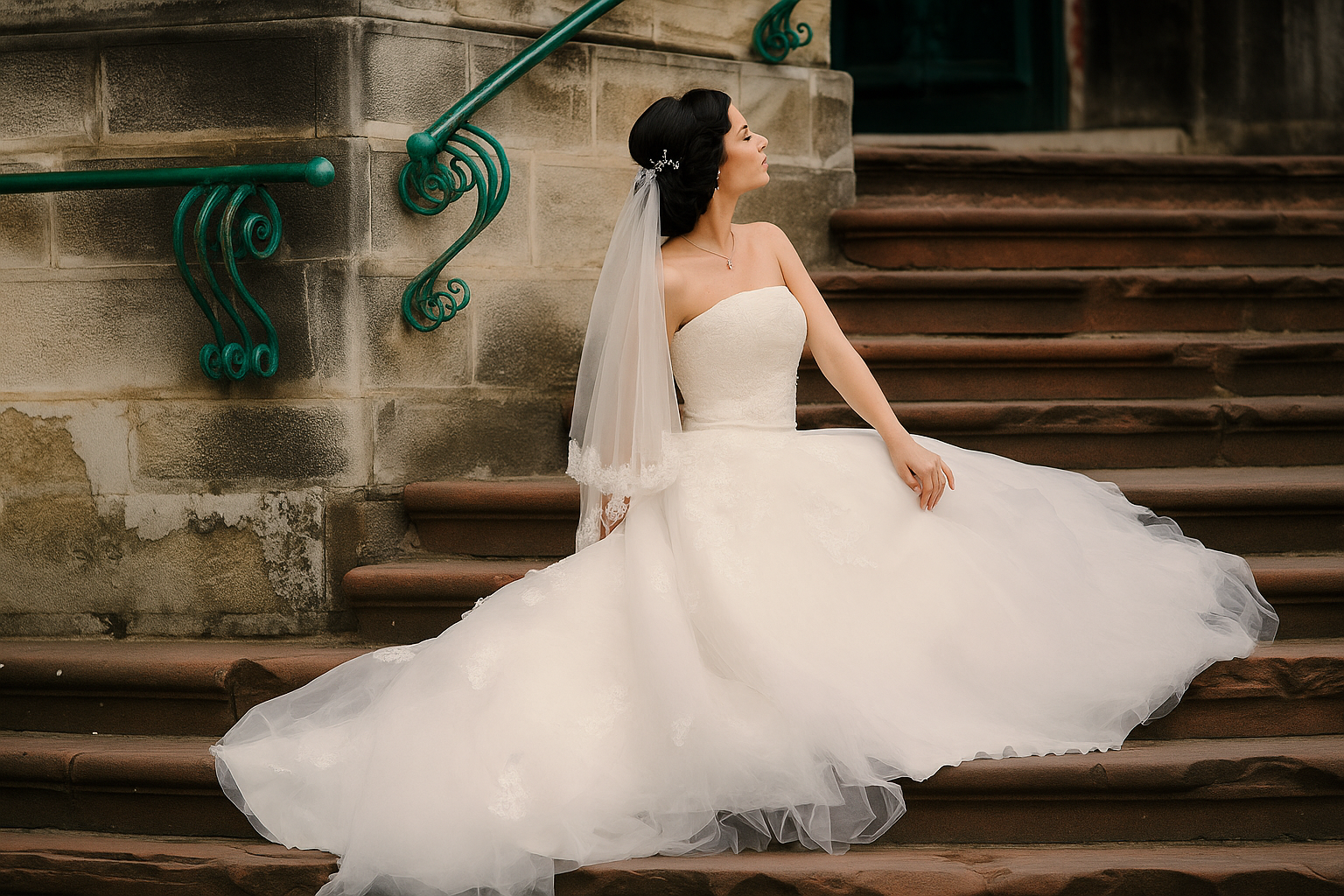What You’ll Learn in This Blog:
-
The five key factors that affect how long your preserved wedding dress lasts
-
Ideal conditions for storing your gown (temperature, light, air, and humidity)
-
Lifespan expectations for different wedding dress fabrics
-
A simple checklist to maximize your dress’s longevity
-
Warning signs that your preserved dress may need attention
-
Answers to the most common questions about dress preservation
Your wedding dress was made for memories—but without the right care, those memories can fade.
Over time, even a carefully packed gown can show yellow spots, brittle fabric, or flattened beadwork.
So, how long does a preserved dress really last?
The truth? It depends on a few key things—how it was cleaned, what materials were used for preservation, and where and how it’s stored.
Understanding this now can make all the difference between a dress that lasts for generations and one that slips away with the years.
What Affects How Long Your Preserved Wedding Dress Lasts?
Small things around your dress can either protect it or cause damage over time. Here are the key factors that decide how long your dress stays beautiful:
Temperature
Heat speeds up yellowing. Cold makes fabric brittle.
Your dress needs balance—a cool, stable space around 60–70°F (15–21°C) is ideal.
Think climate control, not closets near vents or windows.
Light Exposure
Sunlight doesn’t just fade photos—it fades your gown, too.
Even indoor light or plastic covers won’t protect it for long.
The safest spot? A dark, acid-free box stored away from all light.
Air Circulation
Too little air, and you risk mold creeping in.
Too much, and dust settles into delicate threads.
Aim for a breathable container—not sealed shut, but not wide open either.
Humidity
Moisture is your dress’s worst enemy. It causes stains, mold, and fabric to yellow from the inside out.
But bone-dry air isn’t safe either—it can leave your gown feeling stiff and fragile. Keep the humidity level steady—around 50% is just right.
How It Was Preserved
What happened to your dress after the wedding matters just as much as the day itself. Professional cleaning and acid-free packaging give it the best chance at a long life.
Stored at home in plastic or hung in a closet? That’s where the damage begins.
How Long Will Different Fabrics Last?
| Fabric Type | Lifespan with Proper Care | Quick Notes |
|---|---|---|
| Silk | 50–80 years | Needs gentle care, low humidity |
| Satin | 40–70 years | Sensitive to light and moisture |
| Lace | 30–60 years | Very delicate |
| Organza | 30–50 years | Prone to yellowing |
| Taffeta | 40–70 years | Can become brittle |
| Cotton | 50–90 years | Strong but stain-prone |
| Polyester/Blends | 60–100+ years | Most durable, still needs care |
By controlling temperature, light, air flow, humidity, and trusting expert preservation, your wedding dress can stay stunning for generations.
When preserved by us, at DressPreservation, your gown is protected to last over 100 years — keeping your memories alive and beautiful.
How to Maximize the Lifespan of Your Preserved Dress
Follow this simple checklist to help your gown stay beautiful for decades — or even generations:
Before Storing
✔ Have it professionally cleaned.
Remove invisible stains like sweat, sugar, or champagne that can cause yellowing later.
✔ Use a trusted preservation service.
Choose a provider that uses acid-free tissue, museum-quality boxes, and proper sealing.
Storage Best Practices
✔ Store at a stable temperature of 60–70°F (15–21°C).
Avoid attics, basements, garages, or areas near heating/cooling vents.
✔ Keep in a dark place.
Light — especially sunlight or fluorescent bulbs — causes fading and discoloration. Use an opaque, acid-free box.
✔ Maintain moderate humidity (around 50%).
Too much moisture = mold. Too little = brittle fabric. Use a dehumidifier if needed.
✔ Ensure gentle air circulation.
Avoid plastic bags or sealed containers that trap moisture. Proper boxes allow some airflow without dust exposure.
Handling Your Dress
✔ Wash your hands or wear white cotton gloves.
Oils from skin can transfer to the fabric and cause damage over time.
✔ Limit how often you open the box.
Each time the dress is exposed, it risks light, air, and accidental damage.
✔ Keep it lying flat.
Avoid hanging it long-term, which can strain the fabric and seams.
Bonus Tip
✔ Inspect it every 2–3 years.
Check for signs of yellowing, pests, or moisture, and refold gently to prevent permanent creases.
Signs Your Preserved Dress Needs Attention
Even with proper care, your wedding dress might show signs that it needs a little extra love. Catching these early can save it from permanent damage.
Yellowing or Discoloration
If you notice the fabric turning yellow or looking dull, it could mean the dress wasn’t properly cleaned before storage—or that moisture or light is affecting the preservation.
Musty or Vinegar-Like Smell
A strong odor, especially one like vinegar or mildew, is often a sign of moisture buildup. This can quickly lead to mold, staining, or fabric breakdown.
Flattened or deformed Beadwork
If your dress has beading or embroidery and it looks pressed, flattened, or off-shape, it could mean the dress is being stored under too much pressure or in the wrong position.
What to Do Next
If you spot any of these signs, don’t wait. Reach out to a professional who specializes in wedding dress care.
At DressPreservation, we offer inspection and re-preservation services to help restore and protect your gown for the years ahead.
Bottom Line
Your wedding gown wasn’t made to fade—it was made to last. But how long it actually survives depends on what you do now.
With expert cleaning, the right preservation methods, and mindful storage, a wedding dress can stay breathtaking for 80 years or more—sometimes even a century. That’s long enough to become part of your family’s story, not just your own.
So if you want your gown to be more than a memory—if you want it to be a legacy—the time to protect it is now.
Let it tell its story for generations.
Common Questions Brides Also Ask About Wedding Dress Preservation
Can you wear a preserved dress again?
Absolutely! As long as you take the right steps, such as careful handling, professional cleaning, and possible re-preservation, you can wear your preserved dress again.
How do I know if my preserved dress is fine?
To ensure that your preserved dress is in good condition, inspect it thoroughly every few years for any signs of discoloration, stain, fabric degradation, tears, yellowing, loose threads, etc.
Is dress preservation worth it?
Dress preservation is worth it if you want to keep your dress intact. Because without preservation, your cherished gown will quietly but steadily degrade sooner than you’d expect.
How much will it cost to preserve my dress?
The cost of preservation varies depending on the condition of the dress and the service requested. Typically, it can cost anywhere from $200 to $500.
How to store a preserved dress?
A breathable fabric garment bag works for short-term storage, but for the long term, it is recommended that you store your preserved bridal dress in an acid-free archival box.








